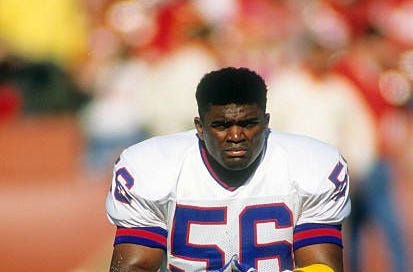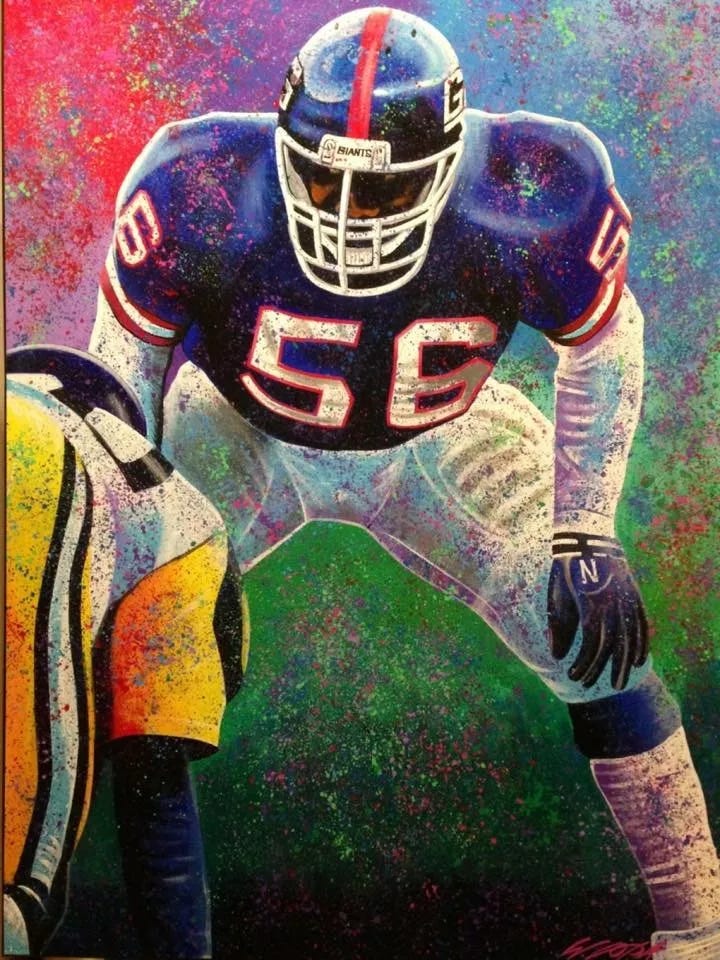Lawrence Taylor The Best Defensive Player Of All Time
Wanted to write an article on the best New York Giant of all time since the NFL season officially began. L.T. is a 2x time Super Bowl winner, 3x Defensive Player Of The Year, 1986 NFL MVP.
Continuing my articles on New York Sports Culture doesn’t matter the sport as long as it’s New York, since the NFL season officially started this week with the Chiefs beating the Ravens on Thursday night football I decided to write about Lawrence Taylor. Taylor was a legend way before I was born, I heard stories about Taylor from other New York Giant’s fans. By the way I am a Giants fan, my cousin Kwasi introduced me to football when I was just 10 years old. He’s a diehard Ravens fan, I was pissed growing up when we played Madden and he picked the Ravens.
Goddamn Ray Lewis with the hit stick analog
Lawrence Taylor, born on February 4, 1959, in Williamsburg, Virginia, is widely considered one of the greatest linebackers in NFL history. His career with the New York Giants was a remarkable blend of dominance on the field and tumultuous personal struggles off it. Taylor's journey to the NFL began at the University of North Carolina, where he established himself as a standout defensive player
At North Carolina, Taylor played linebacker from 1977 to 1980, where he made a significant impact. During his college career, he recorded 132 tackles, 16 sacks, and 2 interceptions. His senior year was particularly impressive, as he accumulated 96 tackles and 16 sacks, earning consensus All-America honors and being named the Atlantic Coast Conference (ACC) Player of the Year. His extraordinary play at North Carolina drew the attention of NFL scouts and solidified his status as a top prospect.
In the 1981 NFL Draft, Taylor was selected by the New York Giants with the second overall pick.
At just 22 years old, he entered the league with high expectations. His rookie season was nothing short of spectacular. Taylor immediately made his mark by recording 133 tackles, 9.5 sacks, and an interception. This performance earned him both the NFL Defensive Rookie of the Year and Defensive Player of the Year awards, setting a high bar for future rookies.
However, while Taylor was excelling on the field, his personal life was beginning to unravel. During his rookie season, he was introduced to cocaine at a party. This initial encounter would soon spiral into a severe addiction. By his third season, Taylor was regularly smoking an ounce of crack cocaine a day. Despite his struggles, Taylor's on-field performance remained exceptional.
In 1982, the NFL season was shortened to nine games due to a players' strike.
Despite this, Taylor continued to shine, recording 7.5 sacks and earning his second consecutive Defensive Player of the Year award. This was a testament to his resilience and ability to perform under adverse circumstances. During this time, Taylor was also using his teammates' urine to pass NFL drug tests, a tactic that allowed him to continue playing while hiding his addiction.
The years 1983 to 1985 saw Taylor maintaining his dominance in the league. He recorded 11 sacks in 1983, 11.5 sacks in 1984, and 13 sacks in 1985. Taylor’s addiction, however, was becoming more pronounced. By this period, his crack cocaine use had become routine, and despite his assertion that it did not affect his performance, the addiction was taking a toll on his personal life.
Taylor’s impact on the field was undeniable. His aggressive play and ability to disrupt offenses made him a nightmare for quarterbacks and offensive coordinators alike. His statistics during these years reflected his extraordinary talent. Despite his drug use, Taylor’s performance did not suffer. His dedication to the game was evident in his consistent production.
In 1986, Taylor had one of the most outstanding seasons of his career. He recorded a career-high 20.5 sacks and won the NFL MVP award, making him one of only two defensive players ever to receive this honor. Taylor also earned his third Defensive Player of the Year award that season.
His performance helped lead the Giants to victory in Super Bowl XXI, where they defeated the Denver Broncos 39-20. Taylor’s play in the postseason was critical, and his presence was a key factor in the Giants' success
The success continued for Taylor, and in 1987, he recorded 12 sacks. However, his personal life was increasingly out of control. During this period, he was caught using his teammates' urine to pass drug tests, a practice that allowed him to avoid suspension. Despite these issues, Taylor’s performance on the field remained stellar.
In 1988, Taylor was finally caught using his own urine for a drug test, resulting in a four-game suspension. This was a turning point in his career, as he faced the consequences of his addiction. Taylor’s drug use was a significant issue, but his performance did not falter. He recorded 15.5 sacks that year, demonstrating his ability to play at a high level despite his personal struggles.
By 1989, Taylor continued to be a dominant force, recording 15 sacks. However, his drug addiction remained a serious issue. Taylor’s personal life was a constant battle, and his addiction was consuming him. Despite this, he remained a key player for the Giants, and his on-field performance was consistently impressive.
In 1990, Taylor helped lead the Giants to another Super Bowl victory, this time against the Buffalo Bills. He recorded 10.5 sacks that season, showcasing his continued excellence despite the ongoing challenges in his personal life. Taylor's role in the Giants' Super Bowl victory was crucial, and his impact on the field was undeniable.
Taylor’s final seasons in the NFL were marked by a decline in performance due to injuries and the continuing effects of his addiction. In 1991, he recorded 7 sacks, and in 1992, he had 5 sacks. His final season in 1993 saw him record 6 sacks. Despite his waning performance, Taylor's legacy as one of the greatest linebackers in NFL history was secure.
Off the field, Taylor's life was marked by continued struggles with addiction. He admitted to spending more than $1,000 a day on crack and prostitutes. His addiction led to multiple arrests, including one in 1997 for buying crack and two in 1998. After his final game in 1993, Taylor immediately returned to using drugs, and he eventually went to rehab for the second time.
One of Taylor’s most infamous moments on the field came during a Monday Night Football game on November 18, 1985, against the Washington Redskins. Taylor sacked quarterback Joe Theismann, resulting in a horrific leg injury that ended Theismann’s career. This sack is remembered as one of the most devastating in NFL history and is a testament to Taylor’s aggressive style of play.
Taylor retired with a career total of 132.5 sacks, 9 interceptions, and 2 Super Bowl championships. He was inducted into the Pro Football Hall of Fame in 1999, a first-ballot honor that reflected his immense impact on the game. His induction was a recognition of his extraordinary career and the transformative effect he had on the linebacker position.
In conclusion, Lawrence Taylor’s career was a mix of incredible achievements and personal struggles. Despite his battles with addiction, he remains one of the most influential and dominant defensive players in NFL history. His impact on the game was profound, and his legacy is a testament to his extraordinary talent and resilience.
The Best New York Giant Of All Time
Thank you for reading another State Of The New York Knicks Substack article.








